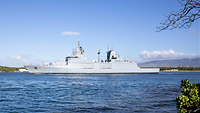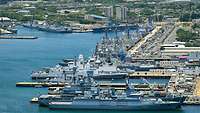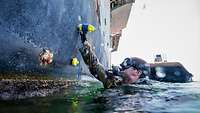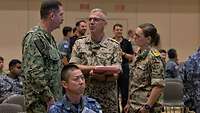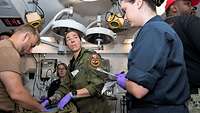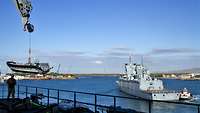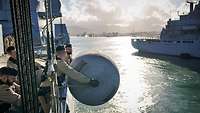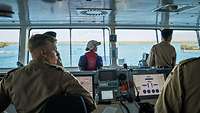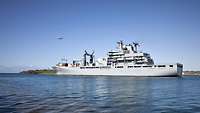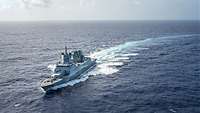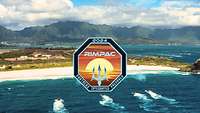RIMPACRim of the Pacific 2024: Departure for the world‘s largest naval exercise
RIMPACRim of the Pacific 2024: Departure for the world‘s largest naval exercise
- Date:
- Place:
- Honolulu
- Reading time:
- 3 MIN
The German Navy‘s frigate FGSFederal German Ship “Baden-Württemberg” and the replenishment ship FGSFederal German Ship “Frankfurt am Main” are taking part in the five-week multinational exercise. RIMPACRim of the Pacific takes place every two years by invitation of the USUnited States Navy. This year it is conducted in the sea areas around the Hawaiian Islands and on the islands themselves.
The exercise officially began on 27 June and will last until 1 August. On 9 July, the majority of the 40 vessels involved left the USUnited States naval base at Pearl Harbor. This marks the beginning of the sea phase of the exercise, which lasts almost four weeks.
The crews used the previous port phase for intensive consultations among the 29 participating nations and for logistical preparation. Land-based individual exercises have also taken place during this time, including training for bomb disposal experts.
The German Navy’s contribution to RIMPACRim of the Pacific consists of the two ships that it has deployed for its Indo-Pacific Deployment (IPDIndo-Pacific Deployment) 2024: frigate “Baden-Württemberg” and replenishment ship “Frankfurt am Main”. They arrived in Hawaii right at the start of the major exercise on 27 June. This is the first time that two German naval vessels are taking part in the major USUnited States exercise. “We look forward to cooperating intensively with our allies and deploying our units with their capabilities,” says the commander of the IPDIndo-Pacific Deployment, Rear Admiral Axel Schulz.
Four weeks at sea for the crews
In total, more than 25,000 sailors, airmen and soldiers have come together for RIMPACRim of the Pacific 2024. In addition to the 40 naval vessels, three submarines and over 150 aircraft are involved. This year, these also include Eurofighter fighter jets from the German Air Force. Land forces from 14 of the 29 participating nations are also taking part.
“The Rim of the Pacific exercise has grown over the years to be the world’s largest and premier joint combined maritime training opportunity,” explains Vice Admiral John Wade, Commander of the USUnited States 3rd Fleet. His command, with the two large naval bases in San Diego, California, and Pearl Harbor, Hawaii, is responsible for the eastern and northern Pacific.
Wade is also commander of the entire RIMPACRim of the Pacific exercise force for the duration. “The exercise’s purpose is to build relationships, to enhance interoperability and proficiency and, ultimately, contribute to the peace and stability in the vitally-important Indo-Pacific region.”
Nations are also demonstrating their interests in the Indo-Pacific through RIMPACRim of the Pacific 2024
Germany also shares this intention to strengthen and develop the rules-based international order in this way, among other aspects of IPDIndo-Pacific Deployment 2024. With the participation of its Navy and Air Force, two branches of the Bundeswehr, in RIMPACRim of the Pacific 2024, the Germany also wants to consolidate its commitment in the Indo-Pacific in close coordination with its most important strategic partner, the USA.
Since 1971, navies of Pacific states and other states interested in the Indo-Pacific region have met every two years at the official invitation of the United States Pacific Command for the RIMPACRim of the Pacific exercise. The full name of the exercise is therefore Rim of the Pacific, a geographical term which includes all countries bordering on the Pacific Ocean.
This year, in addition to the United States, armed forces from the following Pacific countries are represented: Australia, Brunei, Canada, Chile, Colombia, Ecuador, Indonesia, Japan, Malaysia, Mexico, New Zealand, Peru, Philippines, South Korea, Singapore, Thailand and Tonga. There are also non-Pacific participants: in addition to Germany, these are Belgium, Brazil, Denmark, France, India, Israel, Italy, the Netherlands, Sri Lanka and the United Kingdom.
The spectrum of the planned individual exercises now includes an enormous range of military and other capabilities. These include anti-submarine and anti-surface warfare as well as amphibious operations and the interception and control of civilian ships. This year, RIMPACRim of the Pacific also hosts its largest disaster relief exercise to date, involving eight nations and more than 2,500 participants.


